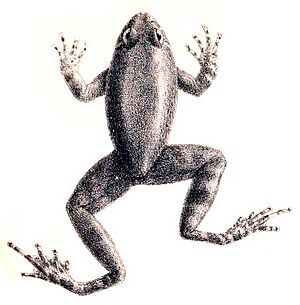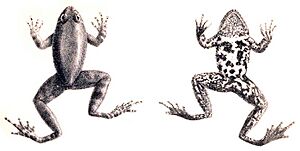Seep frog facts for kids
Quick facts for kids Seep frog |
|
|---|---|
 |
|
| Conservation status | |
| Scientific classification | |
| Synonyms | |
|
Oreobatrachus baluensis Boulenger, 1896 |
The seep frog (also called the Balu oriental frog) is a type of frog. It belongs to the family Dicroglossidae. This special frog likely lives only on the island of Borneo.
Where Seep Frogs Live
The seep frog is mostly found in the northwestern part of Borneo. This includes areas like Sarawak in Malaysia, Brunei, and Kalimantan in Indonesia.
Scientists once thought they found a seep frog in Lampung, Sumatra. However, this sighting is not certain. The frog's name comes from where it was first discovered: "Mount Kina Balu, North Borneo".
What Seep Frogs Look Like
Seep frogs are small to medium-sized frogs. Male frogs grow to be about 25 mm long from their snout to their bottom. Female frogs are a bit bigger, reaching about 35 mm in length.
Their back color can be different shades of brown, grey, or olive green. Sometimes, they have dark marks on their skin. Some seep frogs even have a stripe down the middle of their back. Their belly is usually a creamy color with many brown spots.
Young seep frogs, called Tadpoles, have a long tail. Their tail fin is not very tall, and the tip of their tail is pointed. Their mouth is at the very front of their head and looks quite small.
Seep Frog Homes and Habits
Seep frogs like to live in shallow ponds. They also live in places where water collects in dips in the ground. These spots often have clear water slowly seeping out from the bottom of a hill.
Tadpoles of the seep frog live in the very thin layer of water that covers fallen leaves in these wet areas. They are predators, meaning they hunt and eat other small creatures. They mostly eat tiny invertebrates (animals without backbones).
Sadly, seep frogs are threatened by habitat loss. This happens when their forest homes are cut down, often by clear-cutting.



